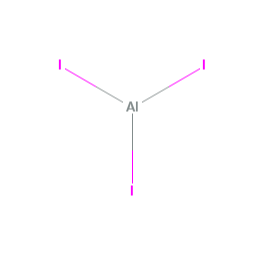Aluminum Iodide Formula
Aluminum Iodide
Aluminum Iodide Formula- Aluminum Iodide is a compound that only contains aluminum and iodine. Also, its forms by the reaction between aluminum and iodine. It is an ionic compound which in certain organic reactions used as a catalyst. Furthermore, it is a hexahydrate that we obtain from the reaction between metallic aluminum and or aluminum hydroxide with hydrogen iodine or hydroiodic acid. Besides, it is a strong Lewis acid and will absorb water from the atmosphere. In addition, we employ it as a reagent for the scission of certain kinds of C-O and N-O bonds. Moreover, it cleaves aryl ethers and deoxygenates epoxides.
Aluminum Iodide Formula and Structure
The chemical formula of aluminum iodide is AlI3. It is dimeric (means it is made of two identical simpler molecules), consisting of Al2I6, similar to that of AlBr3. The gas-phase characterizes the monomeric and dimeric forms of its structure. Furthermore, the monomer, AlI3 is a trigonal planar and the bridged dimer Al2I6 is similar to Al2CL6 and Al2Br6. Besides, the dimer may be referred to as floppy with an equilibrium geometry.

Source: Pubchem
Aluminum Iodide Occurrence
In nature, both elements exist separately, and aluminum iodide forms in special conditions of labs and industries. Aluminum exists in atomic form freely and iodine exists as a molecule I2.
Aluminum Iodide Preparation
Iodine belongs to the halogen family which is highly reactive non-metals. Also, it is a diatomic element which means it is highly reactive and is much more stable in molecular form. That gives I2. Besides, aluminum exists in an atomic form so the reaction between aluminum and iodine is:
Al + I2 → AlI3
The reaction starts with two atoms of iodine and ends with three atoms of iodine. This happens because an aluminum atom needs to lose 1 electron or gain 3 electrons to complete its outer shell electrons. In the same way, iodine needs to either gain or lose 1 electron to complete its outer shell. That’s why aluminum requires three iodine atoms to complete its outer shell.
Aluminum Iodide Physical Properties
It is a colorless powder which has a density of 3.98 g/cm3. Furthermore, its melting point is 189.4oC and the boiling point is 360oC. It has a molar mass of 407.69 g/mol. It can dissolve in substances such as water, ethanol, diethyl ether, carbon disulfide, pyridine, and sulfur dioxide.
Aluminum Iodide Chemical Properties
It is an ionic compound that is used as a catalyst (added to make the process faster) in certain organic reactions and as a spray when treating animal stalls. Also, it releases a great amount of heat, meaning it is exothermic that’s why scientists and industries conduct it in a special heat resistant container and in a fume hood. Purple vapor forms when iodine reacts with aluminum in the presence of water.
Aluminum Iodide Uses
Commonly we use it as an animal stall cleaner where its vapor works. Treatment from it kills the germs that can cause respiratory diseases on the farm. In organic chemistry sometimes it acts as a catalyst that fastens the reaction between elements or compounds. Furthermore, it breaks carbon-oxygen and nitrogen-oxygen bonds. Moreover, it removes the oxygen atom from epoxides.
Aluminum Iodide Health and Safety Hazards
If consumed (by breathing or ingestion) its main target organ is the central nervous system and bone. The aluminum binds with dietary phosphorus and impairs gastrointestinal absorption of phosphorous which results in the softening of bones due to defective bone mineralization and rickets. Furthermore, aluminum high levels in the body link with Alzheimer’s disease. People allergic to aluminum can experience vomiting, digestive disorders, dermatitis or other symptoms. Inhalation of aluminum causes coughing and abnormal chest X-rays.
Solved Examples on Aluminum Iodide Formula
Question: How to prepare aluminum iodide from aluminum triiodide?
Solution: We can prepare it using the following method:
3AlI → AlI3 + 2Al